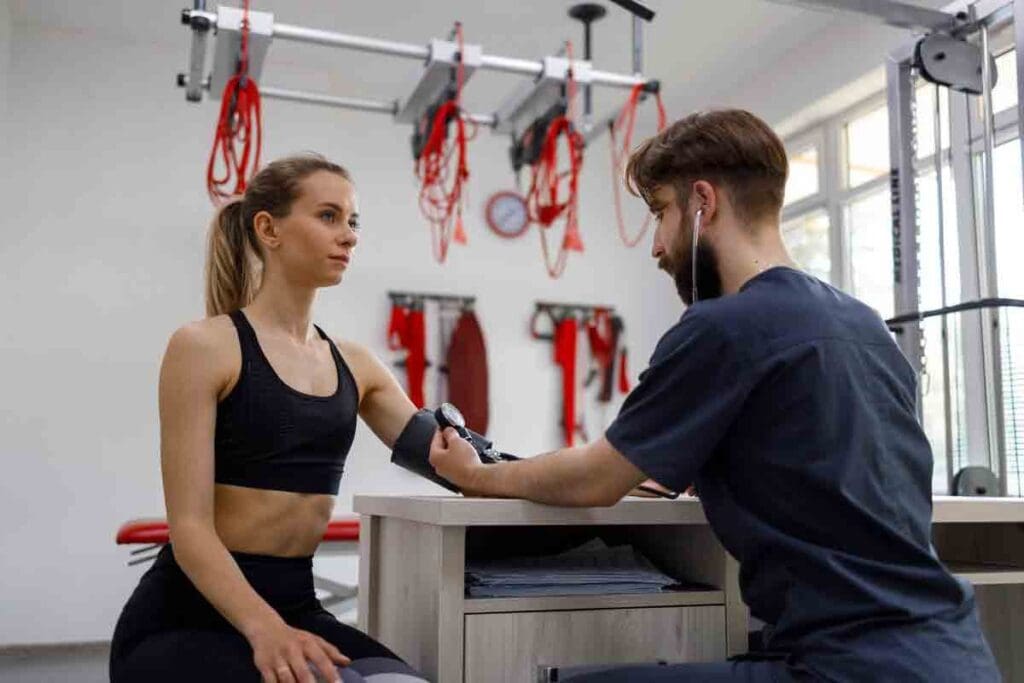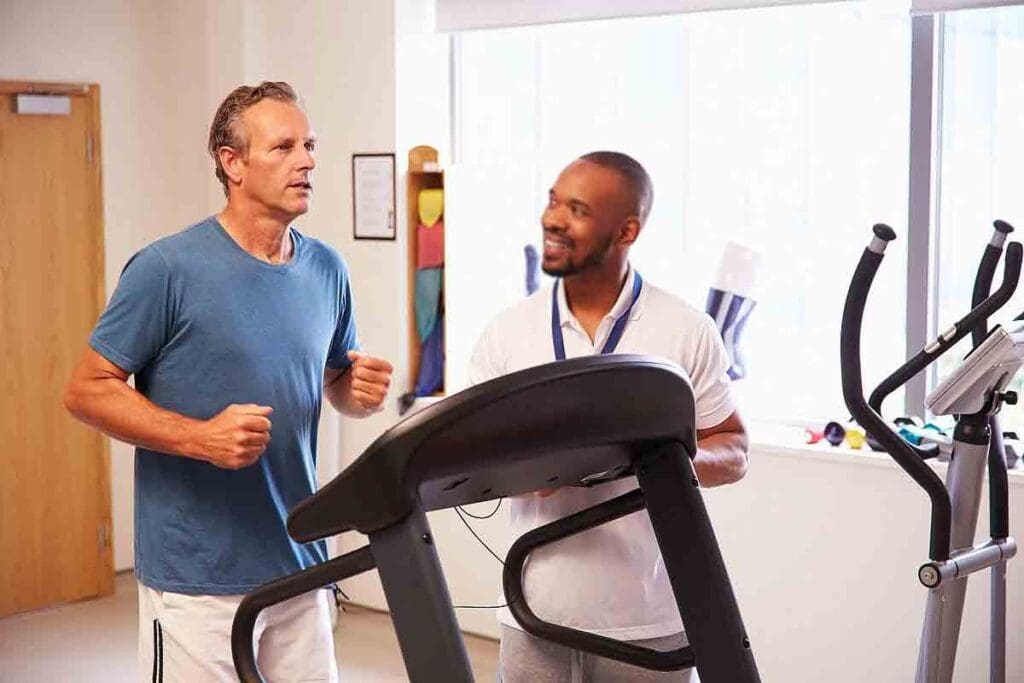
After laparoscopic abdominal surgery, it’s key to start exercising right away. This helps your muscles get strong again and speeds up healing. Doing the right exercises can also prevent problems and make your abdominal muscles stronger.Discover 10 effective exercises for healing abdominal muscles after laparoscopic surgery. Promote a fast, safe recovery with our guide.
There are many reasons for abdominal surgery, and once you get the okay from your doctor, you can start exercising. At Liv Hospital, they focus on keeping patients safe and learning more about healing.
Adding specific exercises to your recovery plan can help you get back to doing things you love. It’s important to do these exercises the right way to heal well.

Laparoscopic surgery is a minimally invasive method used to treat various abdominal issues. It involves small incisions for instruments and a camera. This surgery affects the core muscles and requires careful recovery.
Laparoscopic surgery can strain abdominal muscles in several ways. The use of carbon dioxide gas in the abdomen can put pressure on muscles. Also, the insertion of surgical ports can cause minor muscle damage. Knowing these effects helps in planning a good recovery.
The effects on core muscles include:
Proper healing of abdominal muscles after laparoscopic surgery is key to long-term health. If muscles don’t heal properly, it can cause problems like hernias and chronic pain. A strong core is also vital for physical stability and function.
About 80% of people with Crohn’s disease need surgery. Exercise after surgery helps in recovery and improves overall health. It reduces the risk of future health issues. So, healing and rehabbing abdominal muscles is not just about getting over surgery. It’s about keeping healthy and preventing future problems.

Recovering from laparoscopic surgery needs careful exercise planning. It’s not just about getting strong again. It’s also about improving blood flow, avoiding problems, and helping the body heal.
After laparoscopic surgery, gentle exercises are very helpful. Activities like deep breathing and walking boost blood flow. This lowers the chance of blood clots and helps you feel better overall. Early mobilization is important to avoid complications and help your body heal properly.
Studies show that moving early can lead to better results. It can lower the risk of blood clots and improve breathing. Here are some key benefits of moving after laparoscopic surgery.
| Benefit | Description |
| Improved Circulation | Gentle exercises promote blood flow, reducing the risk of blood clots and promoting healing. |
| Reduced Risk of Complications | Early mobilization helps prevent deep vein thrombosis and other post-surgical complications. |
| Enhanced Respiratory Function | Deep breathing exercises improve lung function and overall respiratory health. |
Not moving enough after surgery can cause serious problems. These include blood clots, pneumonia, and longer recovery times. It’s vital for patients to know these risks and include gentle exercises in their recovery plan.
Research proves that moving early after surgery is beneficial. Patients who move early have shorter hospital stays and fewer problems. By adding gentle exercises to their recovery, patients can help their healing and well-being.
Starting exercises to heal abdominal muscles after laparoscopic surgery is key to recovery. It’s important to wait long enough for healing but not too long. This balance helps build strength and flexibility.
Most doctors say to wait at least six weeks before starting core exercises. But, this can change based on how fast you heal and thy type.
Early Mobilization: You can start with gentle movements and short walks early on. This is under the watch of your doctor.
Intermediate Phase: Once you’re healing well, you can start more specific exercises. This usually happens around 4-6 weeks after surgery.
Before starting any exercise, listen to your body. Look for signs you’re ready. These include:
The type of surgery affects how long it takes to recover. For example:
| Surgery Type | Typical Recovery Time | Exercise Introduction Timeline |
| Diagnostic Laparoscopy | 1-3 weeks | Gentle exercises can start within 1-2 weeks |
| Laparoscopic Hernia Repair | 4-6 weeks | Targeted core exercises can begin around 6 weeks |
| Laparoscopic Cholecystectomy | 2-4 weeks | Gradual introduction of exercises can start within 2-3 weeks |
Always talk to your doctor about when to start exercises. Studies show that exercises after hernia surgery are safe and helpful when done right.
Planning carefully is key to a safe and effective recovery. Before starting any exercise after laparoscopic surgery, know the necessary precautions. This helps avoid complications and aids in healing.
Getting permission from your surgeon, gastroenterologist, and primary care provider is essential. This step is vital to understanding your body’s limits and capabilities after surgery.
Talk to your healthcare provider about your exercise plans. Share the types of exercises you want to do and when you plan to start. They can then tell you if these exercises are safe and right for you.
| Provider | Role in Exercise Planning |
| Surgeon | Provides insights into post-surgical recovery and possible limitations. |
| Gastroenterologist | Guides on managing digestive health during recovery. |
| Primary Care Provider | Checks overall health and advises on safe exercise levels. |
Having a safe space for exercising at home is important. Make sure you have enough room to move, use a non-slip mat for floor exercises, and have emergency contact numbers ready.
Knowing when to stop exercising is critical. Look out for severe pain, trouble breathing, heavy bleeding, or fever.
By following these guidelines and talking to healthcare professionals, patients can safely exercise after laparoscopic surgery. This helps in a smoother and more effective recovery.
Starting your healing after laparoscopic surgery is easy with deep breathing. This simple method is key to a smooth recovery.
Diaphragmatic breathing, or belly breathing, uses the diaphragm for breathing. Lie on your back with knees bent and feet flat. Place one hand on your belly and the other on your chest.
Inhale slowly through your nose, letting your belly rise. Your chest should not move. Exhale through your mouth, letting your belly fall. This boosts lung capacity and gas exchange.
Proper diaphragmatic breathing is shown by your belly hand moving up and down. Your chest hand should stay steady.
Start with 5-10 minute sessions, increasing as you get more comfortable. Aim to do deep breathing exercises at least three times a day. Being consistent is important for the best results.
Deep breathing exercises are great for circulation and muscle activation. They improve oxygenation and blood flow. This helps in healing and lowers the risk of complications.
“Deep breathing exercises help in filling the lungs with air and then emptying them, which aids in circulation and muscle activation.”
More oxygen and better circulation help repair tissues and muscles. The diaphragm’s gentle work also keeps your core stable and improves overall health.
Walking gently is key to improving circulation and engaging your core after laparoscopic surgery. It helps prevent blood clots and aids in healing.
It’s important to walk correctly to avoid discomfort and injury. Here’s how to do it:
Start with short walks (5-10 minutes) and gradually increase the time. Listen to your body and adjust as needed.
| Day | Walking Duration | Intensity |
| 1-2 | 5 minutes | Low |
| 3-4 | 10 minutes | Low to Moderate |
| 5 and beyond | 15+ minutes | Moderate |
Gentle walking can lower the risk of complications like blood clots, pneumonia, and adhesions. It boosts circulation, ensuring your body gets the oxygen and nutrients it needs to heal.
Key Benefits of Gentle Walking:
Adding gentle walking to your recovery routine can help your healing process.
Pelvic tilts are great for strengthening your lower abs after laparoscopic surgery. They are easy to do and don’t put too much strain on you. To do them, lie on your back with your knees bent and feet on the floor. Pull your belly button towards your spine to engage your core.
To do pelvic tilts right, start by lying on your back. Your knees should be bent and your feet flat on the floor, with your hips apart. Pull your belly button towards your spine to engage your core. Then, slowly tilt your pelvis up and back down again. This should be done gently and in control.
Key steps to follow:
As you get better, you can change how you do pelvic tilts. Start with small tilts and slowly do more as you feel more comfortable. When you’re further along in your recovery, try holding the tilt for a few seconds before going back to the start.
Pelvic tilts are super helpful for people who’ve had hernia surgery. They make your lower abs stronger, which helps prevent future hernias and keeps your core stable. Adding pelvic tilts to your recovery plan can help your body heal better and improve your long-term health.
Benefits of Pelvic Tilts:
Pelvic tilts are safe and effective when you start them with your doctor’s help. They’re a great choice for your recovery after laparoscopic surgery.
Modified knee raises are key to getting your core strong again after surgery. They’re great because they can be changed to fit different recovery stages. This makes them good for many people.
To do modified knee raises, lie on your back with knees bent and feet flat. Make sure your back is straight and your core is engaged lightly.
Beginners should start with slow and controlled movements, focusing on proper form over how many times theydo ittt.
As you get stronger and heal, you can make the exercise harder. Here’s how:
A study in the Journal of Surgical Research found that
“Early mobilization and exercise after laparoscopic surgery significantly improve patient outcomes, including reduced complications and faster recovery times.”
| Stage of Recovery | Modification | Benefits |
| Initial Recovery | Single knee raises | Gentle on the core, promotes initial healing |
| Intermediate Recovery | Double knee raises | Increases core engagement, enhances stability |
| Advanced Recovery | Holding knees up for longer durations | Strengthens core muscles, improves endurance |
Patients with umbilical hernia repair should avoid too much strain on their belly. You can modify knee raises by:
It’s important to talk to your healthcare provider before starting any new exercise after surgery.
After laparoscopic surgery, gentle core exercises are key for recovery. They help heal, build core strength, and speed up recovery.
Isometric contractions are great for starting to work your abs without straining the surgical area. Lie on your back with knees bent and feet flat. Engage your core by pulling your belly button towards your spine. Hold for 5-10 seconds while breathing normally. Release slowly and do it again for several reps.
When you’re healing, it’s time to add dynamic movements to boost core strength and stability. Start with simple moves like pelvic tilts and leg slides. Gradually increase the movement and intensity as you get stronger. Listen to your body and stop if you feel pain or discomfort.
Keeping the surgical area stable is key to healing. Gentle core exercises strengthen the muscles around it. Here’s a table showing the benefits:
| Exercise Benefit | Description |
| Improved Core Strength | Enhances overall stability and reduces the risk of complications |
| Enhanced Surgical Site Stability | Promotes optimal healing by reducing strain on the surgical area |
| Better Posture and Reduced Pain | Contributes to a smoother and more comfortable recovery |
Adding gentle core exercises to your post-surgery routine can greatly improve your recovery. Always talk to your healthcare provider before starting any new exercise.
Recovery from laparoscopic surgery can be better with exercises made for your surgery. These exercises help build stronger abdominal muscles. Each surgery needs a special plan to heal well and avoid problems.
After fixing an umbilical hernia, it’s key to do exercises that strengthen the muscles around the surgical area. Pelvic tilts and gentle core activations are good starting points.
For those who have had general laparoscopic surgery, start slowly with exercises. Begin with deep breathing exercises and gentle walking. These improve circulation and help engage the core.
As you get better, try modified knee raises to boost core stability.
When planning a workout after hernia surgery, think about the type of hernia and the surgery method. Choose exercises that help healing without stressing the repair area too much.
| Exercise | Benefit | Post-Surgery Timing |
| Pelvic Tilts | Strengthens lower abdominal muscles | 1-2 weeks |
| Gentle Core Activations | Promotes stability around the hernia repair site | 2-3 weeks |
| Modified Knee Raises | Enhances core stability | 3-4 weeks |
By choosing exercises based on your surgery, you can improve your recovery. This leads to stronger abdominal muscles and a lower chance of complications.
As you move forward after laparoscopic surgery, adding advanced exercises can boost your core strength. It’s key to focus on exercises that strengthen your core, improve overall strength, and integrate your core fully.
The bird-dog exercise is great for strengthening your core. Start on your hands and knees. Make sure your hands are under your shoulders and your knees are under your hips. Lift your right arm and left leg at the same time, keeping them straight.
Hold for a few seconds, then go back to the start. Do the same on the other side by lifting your left arm and right leg. This exercise engages your core, improves balance, and boosts stability.
Modified planks are excellent for building strength, focusing on your core. Start in a plank position on your forearms instead of your hands to ease strain. Your elbows should be under your shoulders, and engage your core by pulling your navel towards your spine.
Hold for as long as you can, increasing time as you get stronger.
Gentle rotations target your obliques. Try the seated torso rotation. Sit on the floor with knees bent and feet flat. Lean back slightly and lift your feet off the ground, balancing on your sit bones.
Hold a weight or medicine ball in front of your chest. Rotate your torso to one side, keeping your arms straight, then to the other side. This exercise strengthens your obliques and boosts rotational flexibility.
Wall slides and bridges are great for integrating your core. For wall slides, stand with your back against the wall and feet shoulder-width apart. Slowly slide your back down the wall, bending your knees, then push back up.
For bridges, lie on your back with knees bent and feet flat on the floor. Lift your hips towards the ceiling, squeezing your glutes and lower back muscles, then slowly lower back down. These exercises integrate your core with your body, improving strength and stability.
Healing abdominal muscles after laparoscopic surgery needs a good exercise plan. The exercises in this article help with recovery and strengthen your abs. They are part of post-surgery exercise routines.
It’s important to make exercise a regular part of your life. By doing these exercises every day, you can speed up your recovery. This also helps in building strong and stable core muscles.
Being consistent is key to healing. Regular exercise helps not just your abs but also improves your overall health. It lets people get back to their usual activities with more ease and confidence.
Exercising after laparoscopic surgery boosts circulation. It also lowers the risk of complications. Plus, it strengthens abdominal muscles, helping you recover faster and more effectively.
When you can start exercising depends on your surgery and how you’re recovering. You can do gentle exercises like deep breathing right away. But, more intense activities should wait a few weeks.
Safe exercises include deep breathing, gentle walking, and pelvic tilts. Modified knee raises and gentle core exercises are also okay. Always check with your healthcare provider before starting any new routine.
Yes, umbilical hernia repair patients should avoid straining their abdominal muscles. They can do pelvic tilts and gentle core exercises instead.
Walking is a great way to prevent complications. It improves circulation, reduces blood clot risk, and aids in healing.
Stop exercising if you feel severe pain, have trouble breathing, get dizzy, or notice unusual swelling. If you notice any of these, talk to your healthcare provider right away.
You can start bird-dogs and planks after a few weeks. Make sure you’ve healed enough and get your healthcare provider’s okay first.
Progress slowly, based on how you’re feeling and recovering. Start with easy exercises and gradually add more intensity and time as your healthcare provider advises.
Yes, stay away from exercises that strain your abdominal muscles too much. Avoid heavy lifting, bending, or high-impact activities until your healthcare provider says it’s okay.
Make sure you exercise in a well-ventilated area. Keep a phone nearby and avoid slippery or uneven surfaces for safety.
It’s vital to talk to your healthcare provider before exercising. They can guide you on the best exercises for your recovery, surgery type, and health, ensuring a safe and effective recovery.
Subscribe to our e-newsletter to stay informed about the latest innovations in the world of health and exclusive offers!